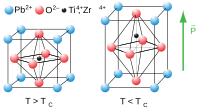锆钛酸铅
锆钛酸铅,是一种无机化合物,化学式Pb[Zr
xTi
1-x]O
3(0≤x≤1),通常缩写为PZT(Lead Zirconate Titanate),是一种白色至灰白色固体。锆钛酸铅是一种有明显压电效应的陶瓷钙钛矿材料,这意味着当施加电场时该化合物会改变形状,被用于超声波换能器、谐振器等。
| 锆钛酸铅 | |
|---|---|

| |
| IUPAC名 锆钛酸铅 | |
| 别名 | 钛锆酸铅 |
| 识别 | |
| CAS号 | 12626-81-2 |
| PubChem | 159452 |
| SMILES |
|
| 性质 | |
| 化学式 | Pb[Zr xTi 1-x]O 3 (0≤x≤1) |
| 摩尔质量 | 303.065 ~ 346.4222 g/mol g·mol⁻¹ |
| 危险性 | |
GHS危险性符号  
| |
| GHS提示词 | 危险 |
| H-术语 | H302, H332, H360, H373, H410 |
| P-术语 | P201, P202, P260, P261, P264, P270, P271, P273, P281, P301+312, P304+312, P304+340, P308+313, P312 |
| 若非注明,所有数据均出自标准状态(25 ℃,100 kPa)下。 | |
锆钛酸铅于1952年东京工业大学发现。与先前发现有明显压电效应的钛酸钡相比,锆钛酸铅表现出更高灵敏度并具更好(较高)的工作温度。陶瓷锆钛酸铅因其物理强度、化学惰性、相对较低的制造成本而广泛应用。陶瓷锆钛酸铅是最常用的压电陶瓷。[1]最近几年,许多国家立法限制商业产品使用铅,因此不少人寻找锆钛酸铅的替代品。[2]
电陶瓷特性
编辑Being piezoelectric, lead zirconate titanate develops a voltage (or potential difference) across two of its faces when compressed (useful for sensor applications), and physically changes shape when an external electric field is applied (useful for actuator applications). The relative permittivity of lead zirconate titanate can range from 300 to 20000, depending upon orientation and doping.[来源请求]
Being pyroelectric, this material develops a voltage difference across two of its faces under changing temperature conditions; consequently, lead zirconate titanate can be used as a heat sensor. Lead zirconate titanate is also ferroelectric, which means that it has a spontaneous electric polarization (electric dipole) that can be reversed in the presence of an electric field.
The material features an extremely large relative permittivity at the morphotropic phase boundary (MPB) near x = 0.52.[3]
Some formulations are ohmic until at least 250 kV/cm (25 MV/米), after which current grows exponentially with field strength before reaching avalanche breakdown; but lead zirconate titanate exhibits time-dependent dielectric breakdown — breakdown may occur under constant-voltage stress after minutes or hours, depending on voltage and temperature, so its dielectric strength depends on the time scale over which it is measured.[4] Other formulations have dielectric strengths measured in the 8–16 MV/米 range.[5]
Uses
编辑Lead zirconate titanate-based materials are components of ceramic capacitors and STM/AFM actuators (tubes).
Lead zirconate titanate is used to make ultrasound transducers and other sensors and actuators, as well as high-value ceramic capacitors and FRAM chips. Lead zirconate titanate is also used in the manufacture of ceramic resonators for reference timing in electronic circuitry. In 1975 Sandia National Laboratories created anti-flash goggles featuring PLZT to protect aircrew from burns and blindness in case of a nuclear explosion.[6] The PLZT lenses could turn opaque in less than 150 microseconds.
Commercially, it is usually not used in its pure form, rather it is doped with either acceptors, which create oxygen (anion) vacancies, or donors, which create metal (cation) vacancies and facilitate domain wall motion in the material. In general, acceptor doping creates hard lead zirconate titanate, while donor doping creates soft lead zirconate titanate. Hard and soft lead zirconate titanate generally differ in their piezoelectric constants. Piezoelectric constants are proportional to the polarization or to the electrical field generated per unit of mechanical stress, or alternatively is the mechanical strain produced by per unit of electric field applied. In general, soft lead zirconate titanate has a higher piezoelectric constant, but larger losses in the material due to internal friction. In hard lead zirconate titanate, domain wall motion is pinned by the impurities, thereby lowering the losses in the material, but at the expense of a reduced piezoelectric constant.
Varieties
编辑One of the commonly studied chemical composition is PbZr
0.52Ti
0.48O
3. The increased piezoelectric response and poling efficiency near to x = 0.52 is due to the increased number of allowable domain states at the MPB. At this boundary, the 6 possible domain states from the tetragonal phase ⟨100⟩ and the 8 possible domain states from the rhombohedral phase ⟨111⟩ are equally favorable energetically, thereby allowing a maximum 14 possible domain states.
Like structurally similar lead scandium tantalate and barium strontium titanate, lead zirconate titanate can be used for manufacture of uncooled staring array infrared imaging sensors for thermographic cameras. Both thin film (usually obtained by chemical vapor deposition) and bulk structures are used. The formula of the material used usually approaches Pb
1.1(Zr
0.3Ti
0.7)O
3 (called lead zirconate titanate 30/70). Its properties may be modified by doping it with lanthanum, resulting in lanthanum-doped lead zirconium titanate (lead zirconate titanate, also called lead lanthanum zirconium titanate), with formula Pb
0.83La
0.17(Zr
0.3Ti
0.7)
0.9575O
3 (Lead zirconate titanate 17/30/70).[7]
另见
编辑参考
编辑- ^ What is "Lead zirconium titanate"?. americanpiezo.com. APC International. [April 29, 2021]. (原始内容存档于2018-08-27).
- ^ Bell, Andrew J.; Deubzer, Otmar. Lead-free piezoelectrics—The environmental and regulatory issues. MRS Bulletin. August 2018, 43 (8): 581–587 [2022-08-28]. ISSN 0883-7694. doi:10.1557/mrs.2018.154. (原始内容存档于2022-08-15) (英语).
- ^ Rouquette, J.; Haines, J.; Bornand, V.; Pintard, M.; Papet, Ph; Bousquet, C.; Konczewicz, L.; Gorelli, F. A.; Hull, S. Pressure tuning of the morphotropic phase boundary in piezoelectric lead zirconate titanate. Physical Review B. 2004, 70 (1): 014108. doi:10.1103/PhysRevB.70.014108.
- ^ Moazzami, Reza; Hu, Chenming; Shepherd, William H. Electrical Characteristics of Ferroelectric Lead zirconate titanate Thin Films for DRAM Applications (PDF). IEEE Transactions on Electron Devices. September 1992, 39 (9): 2044 [2022-08-28]. doi:10.1109/16.155876. (原始内容存档 (PDF)于2015-09-24).
- ^ Andersen, B.; Ringgaard, E.; Bove, T.; Albareda, A.; Pérez, R. Performance of Piezoelectric Ceramic Multilayer Components Based on Hard and Soft Lead zirconate titanate. Proceedings of Actuator 2000. 2000: 419–422.
- ^ Cutchen, J. Thomas; Harris, Jr., James O.; Laguna, George R. PLZT electrooptic shutters: applications. Applied Optics. 1975, 14 (8): 1866–1873 [2022-08-28]. PMID 20154933. doi:10.1364/AO.14.001866. (原始内容存档于2015-02-11).
- ^ Liu, W.; Jiang, B.; Zhu, W. Self-biased dielectric bolometer from epitaxially grown Pb(Zr,Ti)O3 and lanthanum-doped Pb(Zr,Ti)O3 multilayered thin films. Applied Physics Letters. 2000, 77 (7): 1047–1049. doi:10.1063/1.1289064.